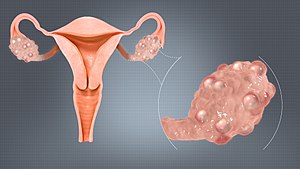Polycystic ovary syndrome
Polycystic ovary syndrome is one of the most prevalent female endocrine health matters. PCOS is a complex and heterogeneous problem of uncertain cause, although there is major evidence that the PCOS can be classified as a genetic health problem. This condition produces symptoms in between five percent to ten percent of females during reproductive ages.
| Polycystic ovary syndrome | |
|---|---|
| Other names | Hyperandrogenic anovulation (HA),[1] Stein-Leventhal syndrome[2] |
 | |
| A polycystic ovary | |
| Medical specialty | Gynecology, endocrinology |
| Symptoms | Irregular menstrual periods, heavy periods, excess hair, acne, pelvic pain, difficulty getting pregnant, patches of thick, darker, velvety skin[3] |
| Complications | Type 2 diabetes, obesity, obstructive sleep apnea, heart disease, mood disorders, endometrial cancer[4] |
| Duration | Long term[5] |
| Causes | Genetic and environmental factors[6][7] |
| Risk factors | Obesity, not enough exercise, family history[8] |
| Diagnostic method | Based on anovulation, high androgen levels, ovarian cysts[4] |
| Differential diagnosis | Adrenal hyperplasia, hypothyroidism, high blood levels of prolactin[9] |
| Treatment | Weight loss, exercise[10][11] |
| Medication | Birth control pills, metformin, GLP-1, anti-androgens[12] |
| Frequency | 2% to 20% of women of childbearing age[8][13] |
Problems include although are not limited to hormones, resulting in acne, hirsutism (excessive hair growth), resistance to insulin (which then results in diabetes mellitus, in particular Type 2 diabetes or latent autoimmune diabetes of adults). Other problems caused by PCOS are being overweight and (in some women) high cholesterol levels. The symptoms and severity vary greatly among affected women.
Treatments include weight reduction, low-dose oral contraceptive pills, medroxyprogesterone and spironolactone. Clomiphene can be used as the treatment for those women who wish to get pregnant.
- ↑ Kollmann M, Martins WP, Raine-Fenning N (2014). "Terms and thresholds for the ultrasound evaluation of the ovaries in women with hyperandrogenic anovulation". Human Reproduction Update. 20 (3): 463–464. doi:10.1093/humupd/dmu005. PMID 24516084.
- ↑ Legro RS (2017). "Stein-Leventhal syndrome". Encyclopedia Britannica. Retrieved 30 January 2021.[better source needed]
- ↑ Cite error: The named reference
NICHD What are the symptoms of PCOS?was used but no text was provided for refs named (see the help page). - ↑ 4.0 4.1 "Polycystic Ovary Syndrome (PCOS): Condition Information". National Institute of Child Health and Human Development. January 31, 2017. Retrieved 19 November 2018.
- ↑ Cite error: The named reference
NICHD Is there a cure for PCOS?was used but no text was provided for refs named (see the help page). - ↑ Cite error: The named reference
De2016was used but no text was provided for refs named (see the help page). - ↑ Cite error: The named reference
Endo2006was used but no text was provided for refs named (see the help page). - ↑ 8.0 8.1 Cite error: The named reference
NICHD What causes PCOS?was used but no text was provided for refs named (see the help page). - ↑ Cite error: The named reference
NICHD How do health care providers diagnose PCOS?was used but no text was provided for refs named (see the help page). - ↑ Cite error: The named reference
Mor2015was used but no text was provided for refs named (see the help page). - ↑ Cite error: The named reference
Gia2009was used but no text was provided for refs named (see the help page). - ↑ Cite error: The named reference
NIH2014Tx1was used but no text was provided for refs named (see the help page). - ↑ Cite error: The named reference
Lub2013was used but no text was provided for refs named (see the help page).
